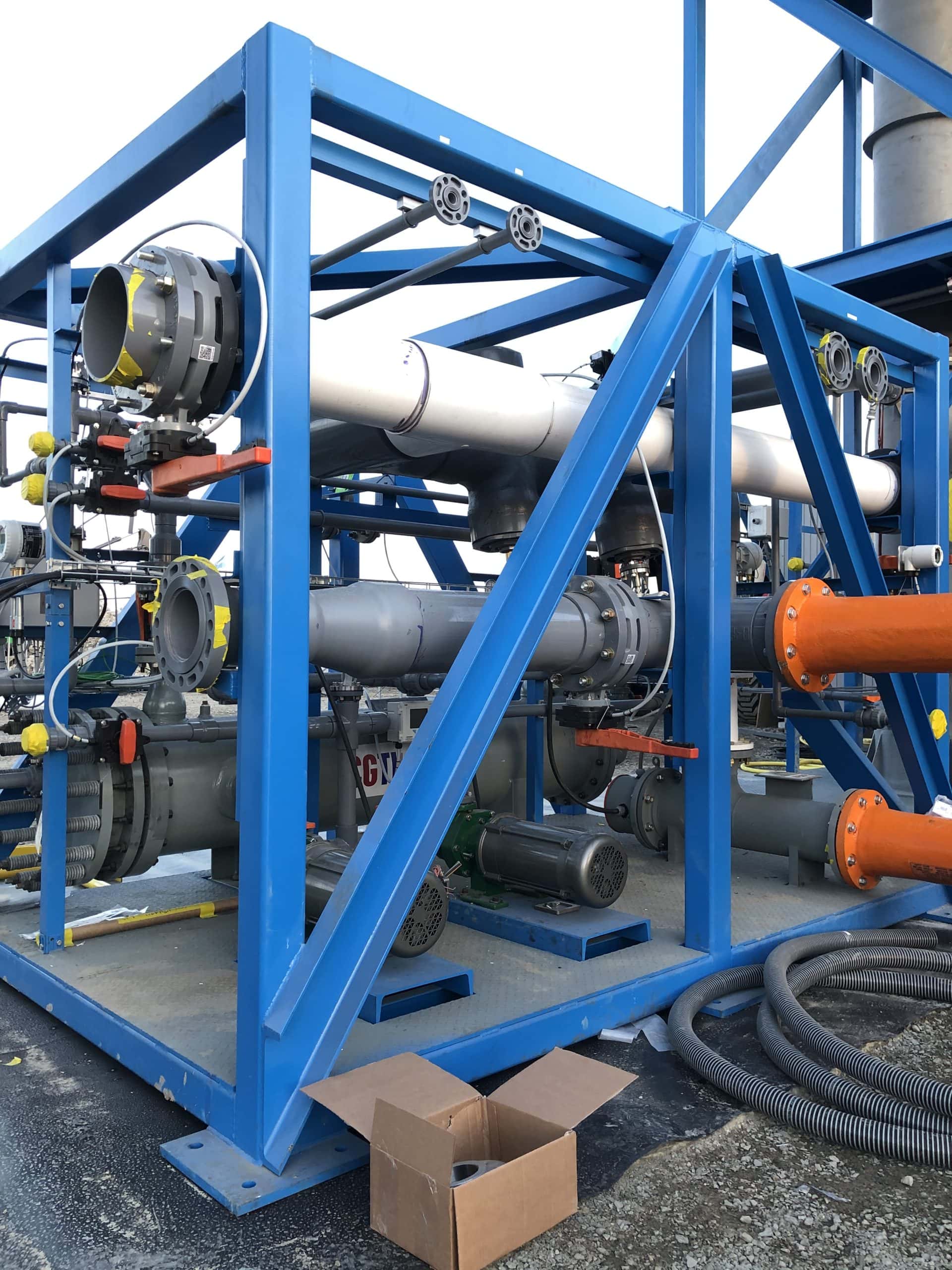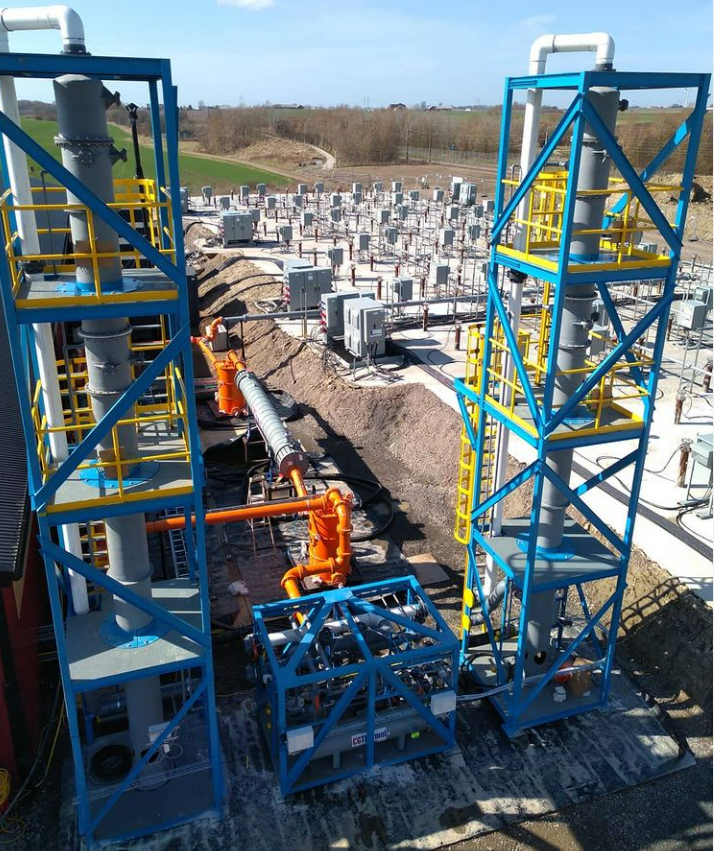Hydrochloric Acid
Material and Design Expertise
Hydrochloric (HCL) acid is a strong reducing agent important to the chemical and steel processing industries. Whether it is used as a feedstock or produced as a by-product, it is highly corrosive with unique properties. Further coupled with the critical nature of the processes in which it is involved, safety and reliability must be foundational to system design. CG Thermal has over 40 years of experience working with HCl. Our design tools have been proven in operation, and our designs have been proven by the test of time. Our experience has provided opportunities for innovation through problem solving. We offer expertise in heat and mass transfer as well as material compatibility when designing systems or individual components. We are heat and mass transfer experts with extensive experience with hydrochloric acid (HC) due to the specialized materials we provide: Impervite graphite, Umax SIC ceramic, PPS-GR composite graphite tube, nickel alloys, fluoropolymer lined, FRP, and other corrosion resistant vessels and components. Safety and reliability are of utmost concern when designing systems for HCl environments. When designing any of the systems mentioned below, we design to achieve the desired results while operating at temperatures and pressures that can be easily controlled. Another key consideration is that materials of construction are available, with appropriate cost and availability, to ensure a long operational life. Following are some of the more common systems involving HCl:
HCl Synthesis
Production of HCL results from a strong exothermic reaction of hydrogen and chlorine. HCL synthesis units are an important part of many chemical operations worldwide, supplying a reliable and cost-effective source of HCL and anhydrous HCL (AHCL) for a wide range of applications. In all cases, it is essential to design-in safety. Proper burner design and management are central to this goal.
HCl Absorption Systems
AHCL is a byproduct of various industrial and chemical processes It can be absorbed into a weak acid stream to produce a desirable HCl concentration. Depending on the feedstock and product required, the method of HCl absorption varies.
Isothermal Systems
Isothermal absorption systems rely on a water-cooled falling film absorber that acts as the main absorption chamber while the acid is cooled. The absorption unit in this system works in a co-current or counter-current mode. In the co-current mode, the liquid and gas are fed at the top of the graphite absorber, and they exit the bottom outlet. A downstream column scrubs the gas, which still contains some HCl, with fresh water and the weak acid leaving the bottom of the scrubber acts as the absorption liquid for the falling film absorber. Isothermal absorption systems work best in high-concentration HCl environments, such as VCM, TDI, silicones, MDI, and fumed silica production because of the large amount of heat generated by the enthalpy of solution.
Adiabatic Systems
Adiabatic absorption systems are generally best for low-concentration HCl gases containing other substances like solvents that require venting. The system is comprised of an absorption column where the gas containing HCl is fed at the bottom of the column and the absorption liquid is fed at the top. The gas and liquid flow in this counter-current mode for maximum absorption. The heat generated during absorption evaporates water so the gas stream leaving the top of the column contains trace HCl and is saturated with water vapor. The water can be removed in a graphite condenser, while the hot acid stream is cooled in a separate graphite heat exchanger. Adiabatic absorption systems are standard in EDC, electronic waste incineration, and chlorinated organics processing.
HCl Desorption Systems
HCl desorption systems produce anhydrous HCl from hydrochloric acid, and can remove contaminants, moisture, and inert gases to produce high-purity AHCl. Central to the system is a column constructed of highly corrosion resistant materials in which the stream is heated to free the AHCl.
Scrubbing Systems
Scrubbing systems are commonly required to remove HCl to safely vent inerts after processing. Many locals have strict emissions regulations and require evaluation for permitting. Accurate simulation is critical to providing a cost appropriate systems that provide the desired performance to ensure a safe environment for the plant and its neighbors.
Azeotrope Breaking Systems
An azeotrope is a specific composition, i.e. ratio of components, of a mixture where the boiling liquid and its vapor have the same composition, henceforth the two substances cannot be separated through simple distillation. Azeotrope breaking systems are essential in HCl production because HCl and water form a high boiling azeotrope at atmospheric pressure and about 20 wt% HCl. This limits the HCl concentration that can be obtain by distillation Therefore, an azeotrope breaking system is required to achieve higher concentrations. Azeotropic breaking systems like extractive rectification technology and dual-pressure technology play critical roles in various processes involving HCl, such as:
- Making AHCl from a weak HCl solution
- Creating AHCl for regeneration of HCl in the production VCM and high purity silicones
- Catalytic oxidation of HCl to Cl2 in the Deacon process in large TDI operations
- Using a strong HCl (32%) to regenerate AHCl
- Waste incineration, silicones, CH2CL PLTS
AHCl Liquefication and Purification
AHCl liquefication and purification systems create liquid or gas AHCl and can concentrate it for sale as a byproduct of VCM production. These systems can also produce high-purity HCl for chloro-alkali production and concentrate the HCl as a byproduct of fumed silica. Liquid HCl has a high coefficient of thermal expansion, so the system’s design should eliminate places where liquid and gas AHCl can become completely sealed between two closed valves due to pressure build-up.
Graphite Purification
The chlorination roasting method is one of the most effective graphite purification methods, yielding more than 98% pure graphite. The process involves the addition of a reducing agent to the graphite and then calcining the mixture at a specific temperature and pressure. Chlorine gas is then passed through the mixture to trigger a chemical reaction that converts the valuable material in graphite into a gas or condensed phase. The process requires effective absorption systems to deal with the gas produced as a byproduct. Chlorination of natural graphite through roasting or fluidized bed reactors is common in making electric car batteries.
Drying AHCl Gas Streams
It is desirable to dry AHCL to allow for less costly and more readily available materials of construction. Dry ACHl is also desirable since it is required for the production of high-purity HCl.This can be accomplished with columns and heat exchangers. Drying can also be accomplished using a molecular sieve . These are natural or synthetic zeolites that have a large adsorption capacity. The sieves are used in the drying of gases and liquids. Mol sieves also separate molecules based on size and shape. Close temperature control is essential to optimizeadsorption capacity and prevent corrosion from highly concentrated gases.
Steel Pickling
In processes like steel pickling, temperature control is critical to guarantee maximum throughput in HCl baths. With an extensive range of heat exchangers, we can ensure you get the best results from every pickling process.
Hydrochloric Acid Processing Equipment From CG Thermal
CG Thermal is an innovation-driven process technology provider passionate about solving problems and delivering client-centric solutions that are tested and proven through time. We are a leader in producing and designing systems to handle corrosive liquids like hydrochloric acids. We have a full range of solutions applicable to various hydrochloric acid processes to guarantee safe handling and optimal results.
Contact us for more information on our products and capabilities.




